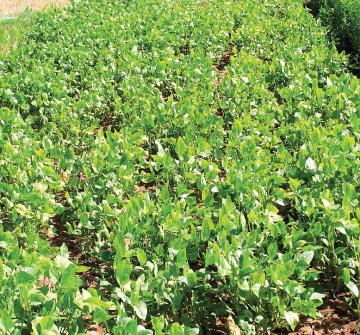
Cowpea, lobia (Vigna unguiculata)
Local names: Hindi: Lobia, Barbati, Alsande Marathi: Chavli Tamil: Karamani Telugu: Bobbarelu, Alasandulu Kannada: Avadai Malyalam: Kottapayaru
Cowpea is important quick growing legume, which fits well in crop rotation. It is adapted to warm summer climate and can be grown on all types of soils, ranging from sandy loams to heavy loams, if they are well drained. It is susceptible to water logging conditions. It can be sown alone or with non-legumes like sorghum and maize. If irrigation is available, this crop can be grown in the months of February and March in India, and then the green fodder can be made available during the critical period of May/ June. As a rainfed crop, it is sown in July. The crop is generally ready in three months. When sown alone, it gives a yield of 200-300 quintals fodder per hectare of land. It has great potential as a mixed crop when sown with maize, sorghum and millets to produce an ideal legume and cereal fodder mixture. It has been observed that the yield of green pods is about 20 quintals per hectare.
Nutritive value
Cowpea is used as fodder crop for green feeding, hay making, grazing and also for ensiling in mixtures with sorghum or maize. The grains are used as human food as well as animal feed. Cowpea is also used as green manure crop and as cover crop in plantations. The feeding value of cowpea forage is high. It is superior to other legumes like soybean because of its low fibre content and minimum wastage in feeding livestock.
The crop can support a 6-7 kg milk yield/ cow/ day without any concentrate supplement. It can be used as a dual purpose crop; that is the green mature pods are removed for human consumption and the residual fodder is used as a cattle feed. When so used, the residual crop forms an excellent fodder which is comparable with any legumes and can support growth and milk production up to 5 kg daily, without any concentrate supplement.
The early fresh leaves and stalks contained 18.0% crude protein, 3.0% ether extract and 26.7% crude fibre. The total digestible nutrient is 59.0% in early and 58.0% in mature cowpea fodder. The calcium and phosphorus content is 1.40 and 0.35%, respectively.
Deleterious factors
The cowpea fodder has low level of anti nutritional and flatulence producing factors than common beans. However, seeds of cowpea contain antinutritional factors such as trypsin inhibitors, lectins and tannins.
Important varieties
EC-4216, UPC-287, UPC-5286, GFC-1, GFC-2 and GFC-4.
